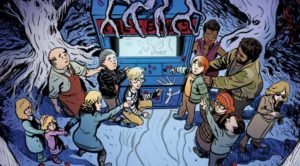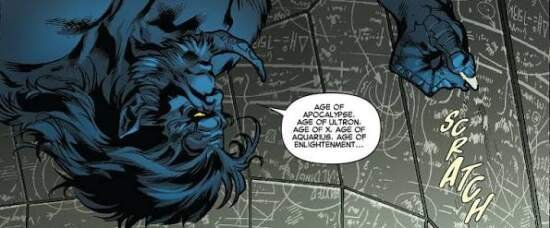Extraordinary X-Men #10 (review)
(Marvel Comics, July 2016)
Writer: Jeff Lemire
“Uncanny X-men” is the title of a long-running comic book series published by US comic book publisher Marvel Comics. The extraordinary success of the title can be laid squarely at the feet of meticulous character writer Chris Claremont, who penned the first series of the title for a phenomenal sixteen years (from 1975 to 1991). During this period Mr Claremont introduced innovative staple elements to the title and its many spin-offs. Some of these are very esoteric but popular with readers: a multiplicity of new and complex characters, nasty mutant xenophobia, the Shi’ar alien empire, the rehabilitation of arch villain Magneto, the poignant death(s) of mainstay character and telepath Jean Grey, and, significantly here, time travel as a vehicle for demonstrating how far down the protagonists of the title and the world can descend into dystopia should the X-Men fail.
This issue has a brief introduction on the very first page which explains what has come in the preceeding issues. The story is set one thousand years into the future, where a rescue mission by a team of contemporary X-Men has gone very wrong. Another team of X-Men travels to the future to rescue the first team. These saviours include an alternate reality future version of the most notorious X-Men character, Wolverine (this aged, future version was popularised in writer Mark Millars’ title, “Old Man Logan” (Wolverine #66-72, Wolverine Giant-Size Old Man Logan, 2008-2009)), and an alternate reality, very young, past version of Jean Grey (the “here and now” version of the character remains dead).
Loyal readers of the many numbers of X-titles published by Marvel Comics must sometimes despair of such tangling of timelines, alternatively, lord their obsessive ability to follow it. One issue of Mr Bendis’ recent work on “Uncanny X-Men” depicts another foundation character, Beast, suffering from debilitating anxiety as a consequence of endeavouring to work out the time lines of X-Men continuity:
The irony here is that this version of Beast is an alternative future version which through the machinations of time travel does not come into existence. It is very confusing.
“X-Men” comics have a long tradition of using time travel, beginning with Mr Claremont’s chilling story entitled “Days of Future Past” (Uncanny X-Men #141-142,1981). Mr Claremont envisaged in this story a world in 2013 well past peak oil (buses are drawn by horses) and in visible decay. Mutants are herded into dire concentration camps. The planet is ruled by mutant-hunting robots called Sentinels. This story was extremely popular with readers and was more or less the foundation of a movie adaption, entitled “X-Men: Days of Future Past” (Twentieth Century Fox, 2014).
The time travel stories in X-Men have slowly built repetition. In Uncanny X-Men #191 (1985), Mr Claremont brought Rachel Summers, the daughter of Jean Grey and another character, Scott Summers, back in time from the “Days of Future Past” dystopia. A mutant-killing robot called Nimrod also travelled into the present from the future, vaguely echoing the core plot of the “Terminator” movies. The master of the mutant hunters, Ahab, came from the future to the past to track both Rachel Summers and the psychic projection of the dead son of Reed and Sue Richards (both characters in another title, Fantastic Four) (Uncanny X-Men Annual #14, 1990). Another child of Scott Summers, with the code name “Cable” (New Mutants #87, 1990), aged and in his 50s, came to the present from the very distant future to lead a team of superpowered mutants called “X-Force”. The time travel permutations with alternative realities generated by various timelines started to bubble away and then boil, and became a hallmark of X-Men titles. Writer Brian Michael Bendis took this one step further when in 2012 he brought to the present the original teenage team of the X-Men from a past time (looking remarkably like the 1960s, when the X-Men were first created by comic book icons Stan Lee and Jack Kirby) (All-New X-Men #1-5, (2012)).
In doing so, Marvel Comics have created a time travel-ridden backdrop that is almost impermeable to the casual reader. Further, Marvel Comics do not engage in the periodic pruning which DC Comics do: rebooting its overarching house plot, its continuity, so as to smooth the way for new readers and snip away at those elements of storylines which either have failed or form barriers for new creative innovations. (DC Comics are in fact entering a new period of regeneration this month.)
This issue does go some way to help that situation, by almost entirely ignoring it. Characters interact with each other in ways which does not presuppose reader knowledge of each of the characters’ complicated chronically-displaced backdrops. Old Man Logan, aside from the very white hair, is indistinguishable from the attitude and demeanour of the contemporary Wolverine. Jean Grey is youthful, but otherwise unremarkable and not at all obviously a time traveller from the past. This refusal to dwell on the tangles of time travel as they have occurred in previous issues is very sensible.
The issue is conceptually an interesting story, but is executed in an unremarkable way. A rescue team travelling to the future to assist stranded mutants. One of the characters, a Russian mutant called Colossus, is subverted and becomes the minion of a long-standing villain, Apocalypse. This character had been killed by Wolverine some time ago but seems to have been revived by Marvel Comics for the purpose of a cross media tie-in with the most recent X-Men movie, “X-Men: Apocalypse” (Twentieth Century Fox, 2016) .
The temporary transformation of superhero characters into agents of Apocalypse has been initiated many, many times by Marvel Comics. This plot device presents scenarios whereby the otherwise altruistic heroes are compelled to fight each other. It is used so often that it is more a cliche than a twist, but one which seems to be popular with regular readers of American superhero comic books.
There is one intriguing quirk to this story. A young mutant called “Glob”, who sadly seems to consist of a pink glutinous and translucent mass surrounding organs and bones, has a high school crush upon the young and beautiful Jean Grey. This is a wonderful subplot following the path of the time-honoured fairy tale allegory of “Beauty and the Beast”. It is difficult to see how it will be played out in this story. The subplot will either lead to a somewhat icky romance, the poor disfigured teenager’s heart being broken, or Glob’s heroic death saving Jean Grey and thereby endearing him to her post-mortem. Or perhaps, as some loves are never resolved, Glob will pine indefinitely. We look forward to Mr Lemire’s take on this.


